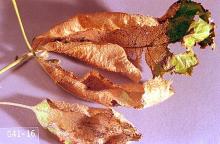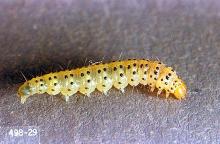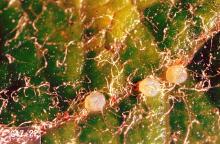Choreutis pariana
Pest description and crop damage Adult moth is reddish brown, with a wingspread less than 0.5 inch and irregular light and dark bands on the wings. Larvae are 0.5 inch in length, yellowish to greenish, with black spots and a yellow-brown head. Pupae are yellow to brown with a white silken cocoon. Larvae skeletonize and roll leaves. Damaged leaves are brown and papery and drop prematurely. Larvae feed on apple, crabapple, and cherry as well as a wide variety of native hosts such as hawthorn, willow, birch and mountain ash.
Biology and life history Adult moths overwinter in crevices in the tree. They lay eggs in small bunches on the undersides of leaves. Larvae emerge and feed on the underside of the leaves. They then move to the top surface to feed, often tying the sides together creating a "rolled" effect. There can be more than one caterpillar in the rolled leaf that becomes skeletonized. After 3 to 4 weeks, larvae pupate in the rolled leaf. Adults emerge after about 2 weeks to start a new generation. There are at least two generations per year.
Scouting and thresholds Watch for signs of skeletonizing, which from a distance looks like the leaf tips have been burned.
Management-biological control
There are many natural enemies of this pest. Avoid broad-spectrum sprays that would disrupt biological control.
Management-cultural control
Larvae and pupae are easily removed from rolled leaves. Remove heavily infested twigs.
Management-chemical control: HOME USE
No chemicals are labeled for specific control of this pest.
Management-chemical control: COMMERCIAL USE
Insecticides used for codling moth or apple maggot also control this pest.





